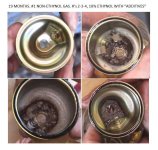I guess this is the best place for this. If not, feel free to move it where it should be.
I have had a few discussions with people recently about ethanol. A couple of the guys I talked with flat out disputed that ethanol causes any problems in internal combustion engines. It just so happens that both of them are farmers that grow corn. Strange, isn't it? LOL! After what my own automotive mechanic has told me and what I have seen inside carbs on small engines that have sat for extended periods with an ethanol blend in them, I'm pretty sure ethanol isn't really good for ANY internal combustion engine. I'm doubly sure it's not good for small engines that sit in the shed for 6 months at a time. That's especially true for any engine that the owner does nothing to prepare the equipment for winter storage. Anyway, I found the screenshot below while searching for additional info on ethanol blended gas. I think it explains the harm that blended gas can cause in a really simplified, yet informative, manner. I intend to print this on an 8"x11" sheet of card stock, stuff it inside a clear, protective sleeve, and then staple it to one of the walls in my garage. I do have a couple of plastic gas caps with symbols indicating that ONLY 5% or 10% ethanol blend is acceptable and also shows that 15% is NOT acceptable.
I did get some good news regarding gasoline available in my area. I thought there was no place in town to buy straight unleaded. My dentist actually told me about a place that offers pure unleaded. He has refused to put blended gas in any of his vehicles or in any of his OPE. One of the two truck stops we have in town has one, single pump that is for straight unleaded. It costs an extra 10 cents a gallon, give or take, but with gas at $3.25 to $3.50, what difference does a dime a gallon make? LOL! I'll be buying 100% of my gas from there effective immediately. I'm going to be REAL curious to see what happens to my mileage. I keep great records of every fill up in the car, so should be able to detect any change in mileage. We'll see.
Oh, and the second point in the screenshot is exactly why I run a can of Seafoam though my car pretty regularly. I know there are other products that will do the same thing, or even better, but since I use Seafoam for so many other things that's what I stick in the car. I was just told recently that the best thing to use for small amounts of water in a vehicle's gas tank is isopropyl alcohol sold at parts stores. I've never tried it, but might get a little to keep on hand. I haven't yet researched it, but I'm wondering what the difference is between the isopropyl alcohol sold at parts stores and isopropyl alcohol sold at pharmacies or even Walmart. Is it the same thing?
View attachment 63250

